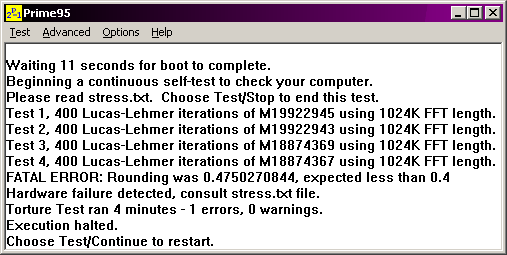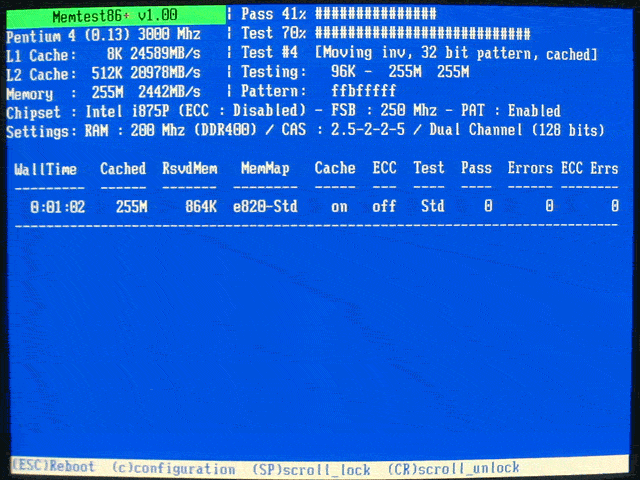How can I check if my overclock is stable? |
|
|
Author: W1zzard
Date: 2004-05-24 07:03:35
|
|
The most frequently used ways to check if your overclock is stable are:
If you have a multiprocessor or HT-enabled system you'll have to run two instances of Prime95 for proper testing. Launch the second Prime95 instance with command-line parameter -A1.

Don't worry if you get a screen like this - your hardware isn't damaged. Most probably your overclock is just too high.
It's also possible that your system will just crash without Prime95 detecting the error.
Another good test is the SiSoftware Sandra CPU Burn in test. But be aware that it wont be able to detect errors like Prime95 does.

Run memtest86 or memtest86+ for several hours at least.
It runs tests of memory reads, writes, copies, and moves in different patterns and block sizes and tests the whole memory range independently of the OS and HDD, PCI devices, etc.


An alternative to testing all-around system stability is just playing your favourite game. It may not be the ultimate in stress testing but you will have a lot of fun while testing.
CPU/Memory overclock:
Run Prime95 in torture mode (Options -> Torture Test) and leave it running for a few hours (or longer)...If you have a multiprocessor or HT-enabled system you'll have to run two instances of Prime95 for proper testing. Launch the second Prime95 instance with command-line parameter -A1.

Don't worry if you get a screen like this - your hardware isn't damaged. Most probably your overclock is just too high.
It's also possible that your system will just crash without Prime95 detecting the error.
Another good test is the SiSoftware Sandra CPU Burn in test. But be aware that it wont be able to detect errors like Prime95 does.
Memory:

Run memtest86 or memtest86+ for several hours at least.
It runs tests of memory reads, writes, copies, and moves in different patterns and block sizes and tests the whole memory range independently of the OS and HDD, PCI devices, etc.
Video Card:
Run 3DMark in an endless loop for a few hours. Signs of instability are artifacts and/or system hangs. Artifacts can be anything from distorted polygons, colored dots and chessboard patterns - everything that looks different from what it's supposed to look like is considered an artifact.

An alternative to testing all-around system stability is just playing your favourite game. It may not be the ultimate in stress testing but you will have a lot of fun while testing.
Jul 18th, 2025 18:52 CDT
change timezone
Latest GPU Drivers
New Forum Posts
- AI Job Losses: let's count the losses up, total losses to AI so far 94,000 and counting (34)
- TPU's Nostalgic Hardware Club (20539)
- 3DMARK "LEGENDARY" (329)
- Hatsune Miku x ASUS TUF Gaming Build (67)
- What's your latest tech purchase? (24304)
- Anime Nation (13051)
- Ferrari themed mod cont. 4070s repaste (7)
- Stalker 2 is looking great. (213)
- Share your CPU-X Benchmarks! (6)
- Are UPS lithium LiFePO4 batteries finally as cheap as lead-acid? (20)
Popular Reviews
- Razer Blade 16 (2025) Review - Thin, Light, Punchy, and Efficient
- SilverStone SETA H2 Review
- Thermal Grizzly WireView Pro Review
- Pulsar X2 Crazylight Review
- MSI GeForce RTX 5060 Gaming OC Review
- Our Visit to the Hunter Super Computer
- NVIDIA GeForce RTX 5080 Founders Edition Review
- NVIDIA GeForce RTX 5050 8 GB Review
- Sapphire Radeon RX 9060 XT Pulse OC 16 GB Review - An Excellent Choice
- Upcoming Hardware Launches 2025 (Updated May 2025)
TPU on YouTube
Controversial News Posts
- Intel's Core Ultra 7 265K and 265KF CPUs Dip Below $250 (288)
- Some Intel Nova Lake CPUs Rumored to Challenge AMD's 3D V-Cache in Desktop Gaming (140)
- AMD Radeon RX 9070 XT Gains 9% Performance at 1440p with Latest Driver, Beats RTX 5070 Ti (131)
- NVIDIA Launches GeForce RTX 5050 for Desktops and Laptops, Starts at $249 (124)
- NVIDIA GeForce RTX 5080 SUPER Could Feature 24 GB Memory, Increased Power Limits (115)
- Microsoft Partners with AMD for Next-gen Xbox Hardware (105)
- NVIDIA DLSS Transformer Cuts VRAM Usage by 20% (99)
- AMD Sampling Next-Gen Ryzen Desktop "Medusa Ridge," Sees Incremental IPC Upgrade, New cIOD (97)